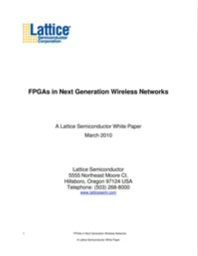FPGAs in Next Generation Wireless Networks
In addition to voice connectivity, digital cellular wireless networks such as GSM and its enhancement, GSM-EDGE, can now provide increased data speeds up to a (theoretical) limit of 384Kbps. Third generation mobile networks, such as CDMA2000 and WCDMA or UMTS (Universal Mobile Telecommunications Standards) and TDSCDMA (China only) are currently being deployed worldwide.
These systems offer services such as video streaming, Internet browsing and, by using a technique called High Speed Packet Access (HSPA), they can in theory deliver downlink speeds up to 14.4Mbps.
Download this whitepaper to learn more.
Read More
By submitting this form you agree to Lattice Semiconductor Corporation contacting you with marketing-related emails or by telephone. You may unsubscribe at any time. Lattice Semiconductor Corporation web sites and communications are subject to their Privacy Notice.
By requesting this resource you agree to our terms of use. All data is protected by our Privacy Notice. If you have any further questions please email dataprotection@techpublishhub.com
Related Categories: Cellular, Communication, Embedded, Power, Processors

More resources from Lattice Semiconductor Corporation
ENABLING MOBILE INTERFACE BRIDGING IN ADAS AND INFOTAINMENT APPLICATIONS
In the automotive market as in all industries, competition breeds innovation. Over the last 100 years, this truth has transformed the horseless car...
ispMACH® 4000ZE - Enabling CPLDs in Ultra High Volume, Low Power Applications
Design engineers are constantly challenged to develop new products with improved features and functionality over previous generation and competitiv...
IMPLEMENTING PCI EXPRESS BRIDGING SOLUTIONS IN AN FPGA
Like its predecessor, the Peripheral Component Interconnect (PCI), PCI Express is becoming a ubiquitous system interface. Unlike PCI, PCI Express a...
